Exfoliation for legs: the best methods and home remedies
Exfoliation is one of the keys to smooth, healthy looking skin. And especially in summer, beautiful, smooth legs can make a significant contribution to making us feel more comfortable in a summer dress or on the beach. Today we will tell you which are the best methods and means for a peeling. The superficial removal of layers of skin is particularly effective against ingrown hair and provides relief against strawberry legs. Even a homemade peeling for legs has many advantages: it is inexpensive, contains no microplastics and you can determine the ingredients exactly to the needs of your skin.
Types of scrubs

There are two types of peels: mechanical and chemical. With mechanical peeling, the skin is physically scrubbed with a body peel, a dry brush or another peeling skin care tool. The chemical peel, on the other hand, uses salicylic acid, alpha-hydroxy acids (such as glycolic acid) or enzymes that smooth the skin structure. These peeling ingredients are also found in face creams, cleaning agents and many other skin care products.
Exfoliation for legs with products bought in the shop
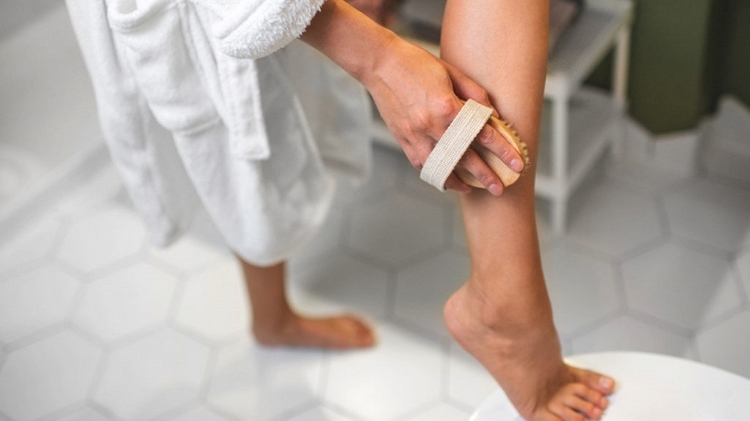
The mechanical peeling products can be used either in the shower or on dry skin. The body peeling can not only remove old dander, but also promotes blood circulation to the skin and the regeneration of healthy skin cells.
Leg peeling brush, loofah, peeling glove etc.

Leg peeling brushes or sponges have a rough texture that removes dead skin when scrubbing. When using the brush or sponge on dry skin, this method is called dry brushing. In addition to exfoliating, dry brushing can also improve circulation, reduce cellulite, and help remove toxins through the lymphatic system. A peeling brush can also be used on damp skin with a normal body wash. There are also peeling gloves and loofah sponges that are perfect for exfoliating in the shower.
Body scrubs with peeling particles

These body scrubs contain fine, granular rubbing substances that gently remove dead skin cells from the skin and thus accelerate cell renewal. Apply the peeling gently to your legs in a circular motion.
Make sure your peel does not contain microplastic beads that can scrub the skin and damage the environment if they get into the drain. In fact, some states have banned these products.
Peels with sugar, almond bran or another natural ingredient with a grainy texture are a much better option. Just don’t use a gritty sugar scrub on your face where your skin is thinner, as it can do more harm than good.
Alpha hydroxy acids (AHAs) and beta hydroxy acids (BHA)

AHAs are chemical peels that remove dead skin cells with acids. Lactic acid and glycolic acid are two of the most common AHAs. Many people hear the word “acid” and fear that AHAs are too aggressive. When used correctly, they can actually look very gentle. AHAs are water-soluble acids that typically come from fruits and gently peel off the top layer of skin.
Salicylic acid is a beta-hydroxy acid (BHA) and occurs as a plant hormone in the leaves, flowers and roots of various plants. It is also a chemical peel, and although it shares properties with AHAs, it penetrates deeper into the skin and is ideal for blemishes and acne. Salicylic acid is also used externally to dissolve the cornea.
Make exfoliation for legs yourself

If you want to do your own leg scrub yourself, you can get inspiration from the following recipes. You just need a few ingredients that you probably have at home anyway.
DIY scrub for legs with coffee
Coffee is an effective remedy for cellulite. To benefit from the activating effect and to reduce the occurrence of cellulite, let the coffee peel work on the skin for a few minutes. Studies show that caffeine can actually help with orange peel.
Recipe: Mix 100 g of coffee grounds with 2 tablespoons of hot water in a bowl. If you have dry skin, add 1 tablespoon of olive oil or coconut oil.
Application: Apply the scrub to clean legs in the shower. It is best to rub the ground coffee in a circular motion and then rinse it out. You may also need to clean the shower after this cure, but the result is worth it.
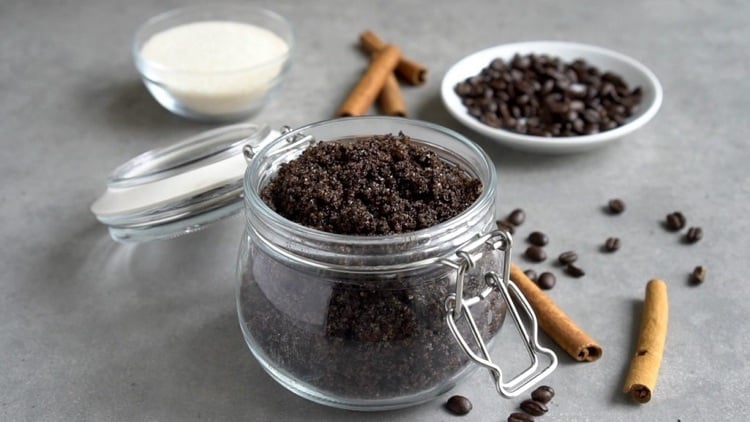
Sea salt peeling
Sea salt is perfect for exfoliating legs. Just make sure that you have no cuts after shaving, otherwise it will burn.
Recipe: Mix 100 g of sea salt, 100 ml of olive oil and a few drops of essential oils (optional).
Application: Apply a small amount of peeling to wet or damp legs and rub in a circular motion.
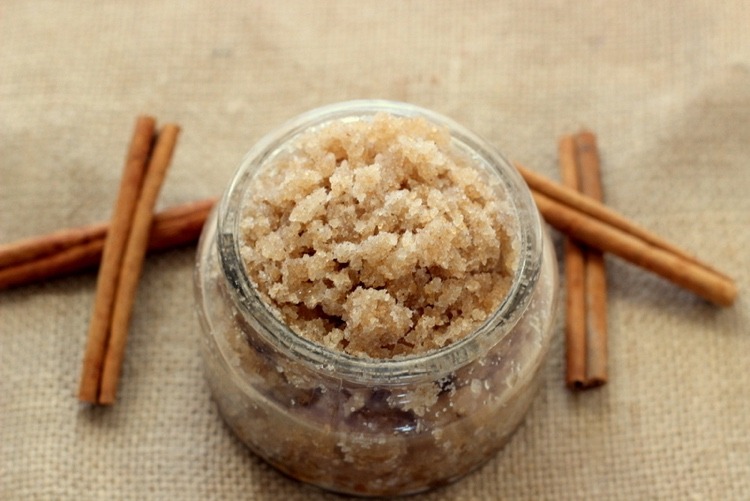
DIY scrub for legs with sugar
Brown sugar is an inexpensive ingredient that you are likely to already have at home. However, do not use it on your face or other sensitive areas of skin. Combine 100 g of brown sugar with 100 ml of oil of your choice. Coconut, olive, almond or grape seed oils are good choices. Apply to your legs in a circular motion and rinse thoroughly.
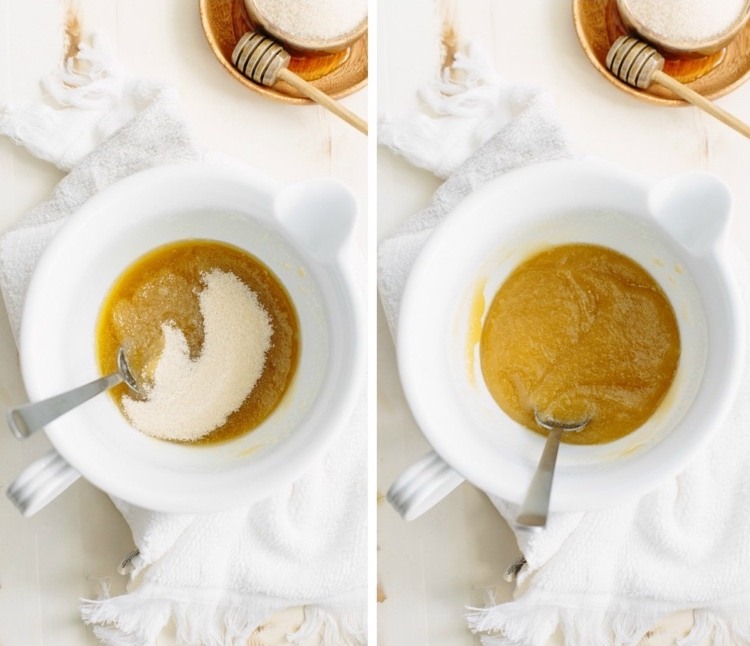
Honey and sugar peeling for dry skin
Honey is considered a real beauty all-rounder and is used in a variety of skin care applications. It moisturizes the skin and has an anti-inflammatory, firming and nourishing effect.
Recipe: Mix 100 g of brown sugar, 3 tablespoons of coconut oil (melted) and 2 tablespoons of honey in a bowl.
Application: Apply the mixture to your legs in a circular motion. It is best to apply it in the shower to avoid the sticky honey getting on other surfaces. Rinse it thoroughly until you feel no more stickiness.
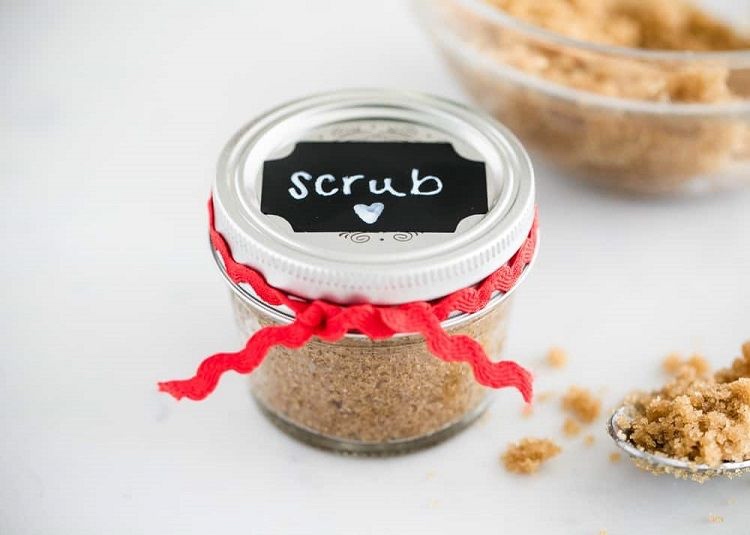
Peeling with baking soda
Make a paste out of baking soda and warm water (approx. 1 tablespoon of baking soda per 1 teaspoon of water) and apply it to your legs in the problem area. Let it work for about three to five minutes before rinsing the mixture with water. The baking soda has an anti-inflammatory effect and gently exfoliates the skin. If you want to make this DIY scrub even more effective, add a tablespoon of finely ground oatmeal.
The correct application of the peels
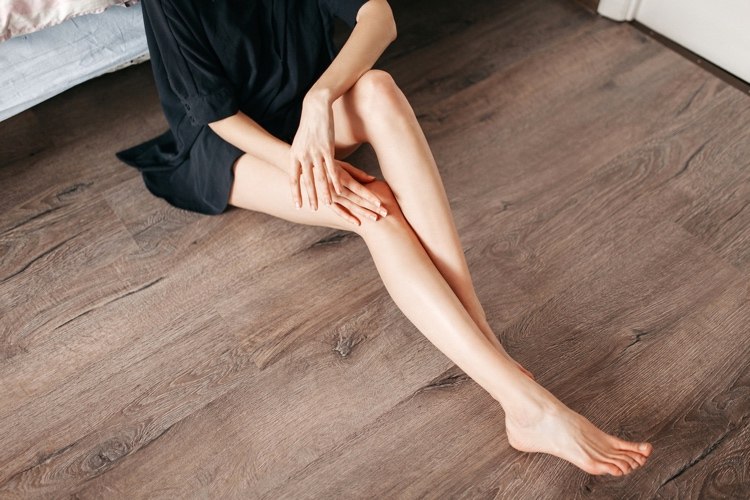
Depending on the peeling method you choose, the right application varies.
Brushes and sponges – There are lymph nodes behind the knee, which you can gently massage with an exfoliating brush. Lymphatic drainage helps to eliminate the body’s excretions. Brush the legs in a circular motion from the thigh towards the ankle. Apply enough pressure to feel it, but not so much that it hurts. If you use a loofah sponge or scrub brush in the shower, make sure your skin is damp and that you use a body wash or oil to avoid skin irritation.
Body scrubs First wash your legs with water. Then put some peeling in the palm of your hand and apply it to your legs in front and back with small, circular movements. If you notice redness or irritation on the skin or if the peeling causes pain, you should stop immediately and rinse it off with water.
AHAs and BHAs – Chemical peels (AHAs and BHAs) can be used a little more often than mechanical peels because they do not rub the skin. Instead of pulling off dead skin, they dissolve the top layer of skin. Some chemical peels are used as an ingredient in a body scrub or body lotion, and they should be washed off. Others are available in the form of sprays, serums or lotions that can be applied overnight and absorbed by the skin.
Exfoliation for legs – how often?

In general, you should not exfoliate more than once or twice a week. The American Academy of Dermatology recommends allowing time for cell regeneration between peels, especially for dry or sensitive skin.
If you have oily skin, you may be able to exfoliate more often. However, it is important to read the instructions on the peels bought in the store carefully and not to be too rough with brushes, sponges or peeling gloves. Mechanical peels generally take 3 minutes to remove dead skin.
Exfoliate your legs before or after shaving?
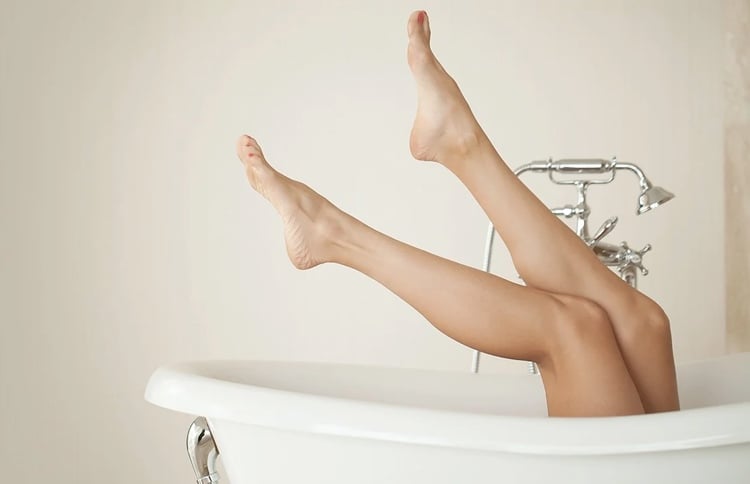
Always make sure to exfoliate your skin before shaving. This helps remove dead skin cells that could clog your razor. Exfoliation is the key to smoothly shaved legs! Shaving exfoliated skin is easier and more effective because your razor is able to get to the root of the hair and shave you as thoroughly as possible. It is also advisable to prepare the skin with a leg peel before epilating. A peeling about 1-2 days before the epilation would be ideal.
Precautions when peeling

There are a few precautions you can take to avoid skin irritation:
- Apply light pressure when exfoliating, but not so much that you get pain.
- Stop peeling when the skin is red, inflamed, or peels.
- Be especially careful in sensitive areas of the legs such as the inside of the thigh and also behind the knee.
- Ask a doctor if you get redness, itching, or an allergic reaction to a product.
- Avoid an additional peeling e.g. Dry brush when using products that contain salicylic acid, retinol or benzoyl peroxide. They are all known for their peeling properties.
Exfoliating your legs is a quick and easy way to get smooth, even skin. You can use a loofah, glove, brush, scrub, or chemical peel. Always be careful not to rub your skin too hard as this may damage the skin barrier and cause skin irritation. Watch your skin and avoid exfoliation if it starts to peel or hurts.
The post peeling for legs: The best methods and home remedies appeared first on Deavita.com | Living ideas, design, hairstyles, make-up, lifestyle, health and beauty tips.





















